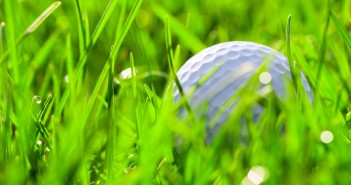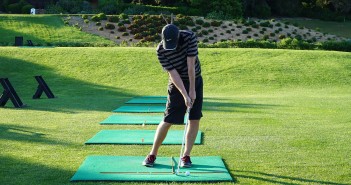When playing from the rough, it’s impossible to be sure of the effect that the long grass will have on the shot – even for the best players in the world.
Just a single blade of grass between the club face and ball at impact can significantly affect the forces applied to the golf ball and the amount of backspin produced as a result.
The distance that the ball flies is mostly determined by club head speed, which imparts ball speed through the normal contact force – the force directed perpendicular to the club face at impact.
The amount of backspin on the ball is determined primarily by spin loft and club head speed, but also by the frictional force along the club face plane.
Spin loft is the angle between club face orientation (dynamic loft) and club head direction (attack angle).
In general, a club with more loft generates more spin, up to the point where there is not enough friction to “grip” the ball.
If there is grass and/or water between the ball and the club, the friction will be reduced, and a low spinning “flyer” is a likely result – the ball coming out low and often flying off the back of the green.
From the Thick Stuff
Heavy rough is very likely to reduce club head speed before impact, and thus reduce the normal contact force applied to the golf ball.
Also, a large amount of grass between the club face and the golf ball at impact will significantly reduce the normal contact force and the frictional force applied to the golf ball.
Less normal contact force equals less ball speed and spin. Less frictional force equals less spin.
In addition, the grass is likely to alter the dynamics of the club/ball contact surface, and the resulting ball flight will probably be lower because of a reduced effective dynamic loft. Lower dynamic loft equals less spin loft and thus less spin.
The result will be that the shot won’t carry as far, it will fly lower, and it will have less spin than when played from the fairway.
Reduced spin and the lower flight will mean that the ball will roll further after it lands
All of these factors will be impossible to predict accurately.
From Light Rough
Just a few blades of grass between the club face and the golf ball at impact will make the overall distance of the shot very difficult to predict with any certainty.
Even though this small amount of grass won’t have much effect on the normal contact force, and so the ball speed will be similar, the reduction in the frictional force may be significant but unpredictable. Thus the resulting spin will be unpredictable.
Again, the grass is likely to reduce the effective dynamic loft, and lower dynamic loft equals less spin loft and thus less spin.
This is especially true for the higher-lofted short irons, where the ball spins much more, and the ball would not normally be expected to roll much after landing. The ball flight will be lower and the ball will spin less and roll further (by an unpredictable amount).
Longer irons spin the golf ball less from the fairway, so when playing from light rough the effect of reduced spin is less significant overall.
The Effect of Skill
Most high handicappers prefer to hit the ball from the semi-rough than from the fairway.
They actually launch the ball higher and produce more spin from the semi-rough than from the fairway.
This is because the ball often sits up a little on top of the semi-rough grass, a bit like playing off a tee.
These players don’t often strike the ball cleanly from the fairway, and so are unable to control the ball flight and spin even from a perfect lie.
Good ball-strikers, however, always prefer to play from the fairway – they prefer tight lies that enable them to know with some certainty how the ball will behave when struck properly.
Equipment
The grooves on the club face are there primarily to provide friction when playing from an imperfect lie or in wet conditions.
The laws on groove shape were changed recently to reduce friction, and so make it more difficult to control the shot predictably when playing out of the rough, especially with higher-lofted short irons.
Different types of golf ball all have different spin characteristics, but these are less relevant when playing out of the rough.
Grass Types
The quality of the rough grass can have a significant effect on golf ball spin.
Fpr example, Bermuda grass is thicker than Poa annua – it has a greater average volume per blade.
This means that, when playing out of Bermuda rough, both the normal contact and frictional forces will usually be less than when playing out of Poa annua rough. So the ball will carry less and roll further, with less predictability.
How to Play
We’ll be discussing how to play from difficult lies in great detail elsewhere, but these simple setup changes will help you get on the green from thick rough:
If the grass is growing away from the target:
- Take one more club – the grass is going to slow down the club head before impact.
- Setup closer to the ball and use extra wrist hinge to produce a steeper swing – this will mean that less rough gets in the way of your club head to slow it down and deflect it.
- Play the ball slightly further back in your stance, again to encourage a steeper, more up-and-down swing.
- Open the club face a few degrees to counter the fact that the grass is likely to grab the hosel and shut the club face through impact.
If the grass is growing towards the target:
The classic “flyer lie”. This shot is slightly easier, but your chances of getting a flyer are higher.
- Expect more roll and take one club less – the grass won’t slow your club head down so much here but you’ll get a lot less spin.
- Setup normally but use extra wrist hinge to produce a steeper swing – this will mean that less rough gets in the way of your club head to slow it down and deflect it.
- Play the ball slightly further forwards in your stance.
- Swinging steeply doesn’t mean getting all “armsy”. You still need to make a full shoulder turn, just use more wrist hinge going back and strike sharply down on the ball.
If you have any questions or comments about this or other articles on Golf Loopy, please send us an email.
» The Mechanics of Golf Ball Flight.




